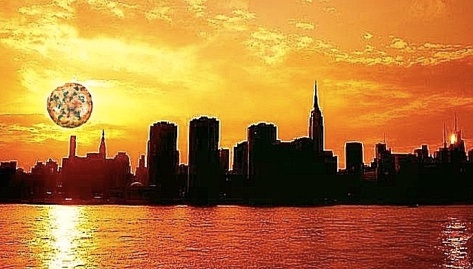
Long Life for
Our Star Trash
Since ancient times, people looked up at the sky and dreamed about the future, new worlds, or whether it’ll rain or shine. These days, they look out for something else: space junk. Statistically, the 60 to 80 tons of metal garbage we’ve once sent aloft and now comes back to Earth every year has little chance to hit anyone, personally.
Which doesn’t mean it can’t. Most actually get burned while entering our atmosphere. A lot dive straight to the sea, which covers most of the planet’s surface anyway. Then there’s the stuff that falls in deserted areas, and few even notice it. That leaves a small, tiny, teeny percentage of flaming rocks that, yes, can crush you to death.
We don’t want to worry you too much. After all, if this was Saturday, we’d be doing better featuring cat pictures. But think about a lottery, for instance, and the buck you risk weekly, hoping to change your life with a struck of a number. Well, chances of hitting the jackpot are roughly equivalent to chances of being hit by falling debris. So.
Let’s take a quick look at what’s up there, what may have reached its expiration date some time ago, and what’s getting closer and closer to reentry, shall we?
FLYING LITTER
The straight dope: right now, there are about 500,000 known pieces of space junk in orbit, including items 0.5 inches wide, and 21,000 objects larger than four inches in diameter, all currently being tracked by the Department of Defense’s U.S. Space Surveillance Network.
But if that makes you relax, you don’t know what’s coming at you at 17,500mph: once an object larger than those four inches reenters the atmosphere, it’s virtually impossible to know where exactly it’ll land.
A few years ago, a 2.5-ton scrap, left over after disabled German satellite Rosat reentered the atmosphere in October, missed Beijing and millions of residents by a matter of minutes. The 21-year old Rosat fell instead on the Bay of Bengal a few moments from the Chinese city.
Given the size of that thing, it’d have been, of course, a major catastrophe. But at that kind of speed, size is not really that relevant. There have been collisions in space between debris and operating satellites, or even misguided attempts at destroying them in orbit. That only increased the amount of high-speed junk circulating the Earth.
The International Space Station has had to dodge debris several times and even has a procedure for astronauts to adopt in such an event. And they did have to evacuate the ISS under the threat of a collision a couple of times. As you know, even a tiny bit of racing metal can disable the station and they’d have to abandon it for good.

ETERNAL LANDFILL
The only thing certain about this dangerous by-product of our space adventures is that it’ll all eventually fall back to Earth, and there isn’t much that can be done about it. NASA’s Orbital Debris Program Office has been trying to address the problem for quite some time now.
The program’s main goal is to find ways to avoid collisions, specially when launching new satellites that, ultimately will also contribute to the pile. Or soon, there won’t be a way to safely launch them up at all. But NASA is historically plagued by budget concerns anyway.
The same goes, by the way, to its Meteoroid and Orbital Debris Program Offices. All both programs can do is to track some of the objects. There isn’t any practical plan to do away with the problem which, in the case of meteorites, has the potential to end our civilization.
But before the hawks who like to blame the government for incompetence start to croak, see if there’s any initiative from the private sector to deal with the issue of space debris. Or with errant meteors, for that matter. That’s because there isn’t.
And to show that in matters of space, we’re really falling behind, while we argue about government spending and earth-bound priorities, the Swiss has come up with a way. Expensive, lengthy but better than nothing. Let’s see if it gets off the ground. We hope it does.
Even sexier programs, such as space travel, have a hard time finding deep pockets to get off the ground. So, like education, health care, defense, and individual freedom, either the government steps in or it’s every man for himself. That’s how it already looks like anyway.

WHAT GOES UP…
Two dramatic examples, coincidentally both Russian-made crafts, underline the need for us to, well, at least keep an eye on the sky. The $160 million Phobos-Grunt satellite, and the $65 million Meridian communications satellite both malfunctioned either in orbit or right before reaching it and crashed back shortly after launch.
Besides the huge amount of money literally burned with the failed projects, and the effect they had on Russia’s once proud space program, there’s something else about them: they both could’ve hit a major city and caused a catastrophic event. Not this time, thank goodness.
Before we forget, let’s quickly address the one-track minded, shoot from the hip, Monday quarterbacks out there who have one ‘solution’ to this problem: to blast it, either with lasers or some other video-game-inspired solution. Well, let’s us be the ‘Nth’ party to tell you all: it does not work, either with satellites or meteorites.

China already tested in 2007 this disastrous theory, which has even its own name, the Kessler Syndrome, when it blasted an aging weather satellite, only to create about 2,500 pieces of new debris. It happened again two years later, though, in a head-on collision between U.S. Iridium satellite and a defunct Soviet Cosmos spacecraft.

Add another 1,000 pieces of trackable debris to the space landfill tally up there. And so on. The consequences of blasting a meteor in outer space, supposedly using nuclear power, as many advocate, are unpredictable and, most likely, absurdly devastating. But, if the rock’s really heading toward us, who knows?
PERMANENT GRIDLOCK
With over 50 nations now actively launching rockets to space, the traffic jam is obviously increasing. And speaking of nukes, some of these do have nuclear powered engines, and are not any safer than the usual sources of propulsion. That was the case in 1978, with a secret spy Soviet satellite.
The Cosmos 954, which had compact nuclear reactors for each of its radar antennas, spiraled out of control and fell to Earth, shedding debris across the frozen ground of the Canadian Arctic. It required a major cleanup operation, obviously motivated by its military purposes.
The number of space debris is projected to triple by 2030, and if today there are probably 10 times more objects in space than we’re able to track with our current sensor capability, imagine how it’ll be then.
There’s growing awareness of the problem and spacecraft built nowadays are relatively superior than those launched before, in what they use lighter materials, are more energy efficient, have longer life spans, and can more easily be tracked and even brought back to Earth for recycling, instead of just crash-landing.
That being said, and even if unrealistically, we’d consider stopping launching anything else to space, there’s still the problem of what’s already there. Perhaps in a 100 years or so, if we’re still around, we’ll send some kind of space-age, small-planet sized shredder to turn it all into something we can reuse. Stardust, anyone?
But that’s, well, a fairy-dusted way of imagining the future. Just like imagining the you’ll hit the lottery someday. Which doesn’t mean we don’t want you to, just don’t forget us. Or the fairies. And, for crying out loud, take at look at the sky above you, every once in a while.
* Originally published on 8/15/2011.











































